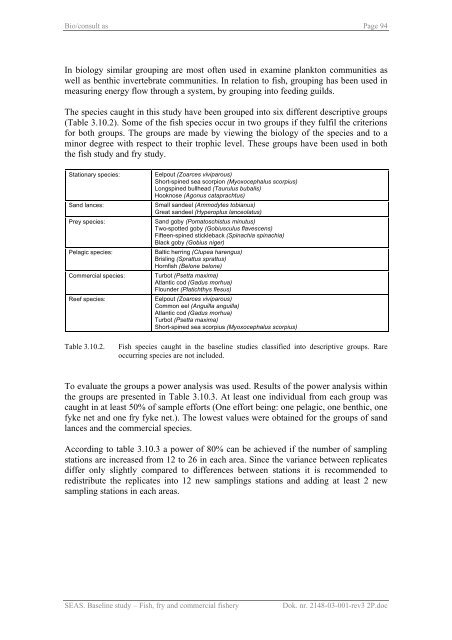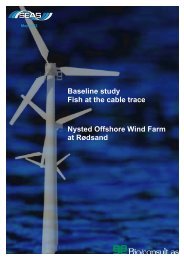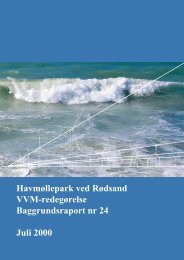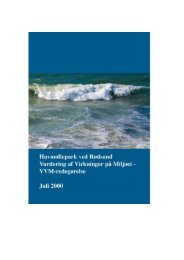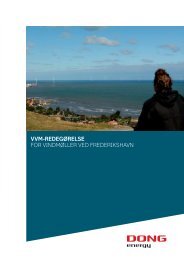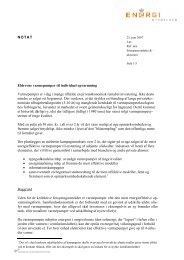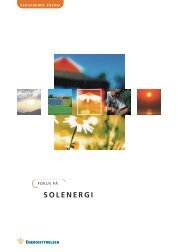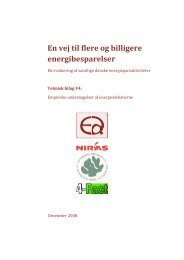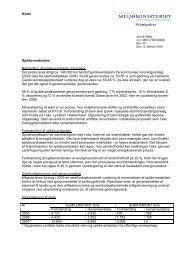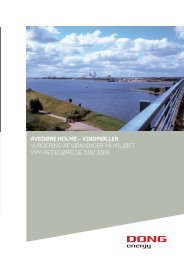Baseline study Fish, fry and commercial fishery Nysted Offshore ...
Baseline study Fish, fry and commercial fishery Nysted Offshore ...
Baseline study Fish, fry and commercial fishery Nysted Offshore ...
You also want an ePaper? Increase the reach of your titles
YUMPU automatically turns print PDFs into web optimized ePapers that Google loves.
Bio/consult as Page 94<br />
In biology similar grouping are most often used in examine plankton communities as<br />
well as benthic invertebrate communities. In relation to fish, grouping has been used in<br />
measuring energy flow through a system, by grouping into feeding guilds.<br />
The species caught in this <strong>study</strong> have been grouped into six different descriptive groups<br />
(Table 3.10.2). Some of the fish species occur in two groups if they fulfil the criterions<br />
for both groups. The groups are made by viewing the biology of the species <strong>and</strong> to a<br />
minor degree with respect to their trophic level. These groups have been used in both<br />
the fish <strong>study</strong> <strong>and</strong> <strong>fry</strong> <strong>study</strong>.<br />
Stationary species: Eelpout (Zoarces viviparous)<br />
Short-spined sea scorpion (Myoxocephalus scorpius)<br />
Longspined bullhead (Taurulus bubalis)<br />
Hooknose (Agonus cataprachtus)<br />
S<strong>and</strong> lances: Small s<strong>and</strong>eel (Ammodytes tobianus)<br />
Great s<strong>and</strong>eel (Hyperoplus lanceolatus)<br />
Prey species: S<strong>and</strong> goby (Pomatoschistus minutus)<br />
Two-spotted goby (Gobiusculus flavescens)<br />
Fifteen-spined stickleback (Spinachia spinachia)<br />
Black goby (Gobius niger)<br />
Pelagic species: Baltic herring (Clupea harengus)<br />
Brisling (Sprattus sprattus)<br />
Hornfish (Belone belone)<br />
Commercial species: Turbot (Psetta maxima)<br />
Atlantic cod (Gadus morhua)<br />
Flounder (Platichthys flesus)<br />
Reef species: Eelpout (Zoarces viviparous)<br />
Common eel (Anguilla anguilla)<br />
Atlantic cod (Gadus morhua)<br />
Turbot (Psetta maxima)<br />
Short-spined sea scorpius (Myoxocephalus scorpius)<br />
Table 3.10.2. <strong>Fish</strong> species caught in the baseline studies classified into descriptive groups. Rare<br />
occurring species are not included.<br />
To evaluate the groups a power analysis was used. Results of the power analysis within<br />
the groups are presented in Table 3.10.3. At least one individual from each group was<br />
caught in at least 50% of sample efforts (One effort being: one pelagic, one benthic, one<br />
fyke net <strong>and</strong> one <strong>fry</strong> fyke net.). The lowest values were obtained for the groups of s<strong>and</strong><br />
lances <strong>and</strong> the <strong>commercial</strong> species.<br />
According to table 3.10.3 a power of 80% can be achieved if the number of sampling<br />
stations are increased from 12 to 26 in each area. Since the variance between replicates<br />
differ only slightly compared to differences between stations it is recommended to<br />
redistribute the replicates into 12 new samplings stations <strong>and</strong> adding at least 2 new<br />
sampling stations in each areas.<br />
SEAS. <strong>Baseline</strong> <strong>study</strong> – <strong>Fish</strong>, <strong>fry</strong> <strong>and</strong> <strong>commercial</strong> <strong>fishery</strong> Dok. nr. 2148-03-001-rev3 2P.doc


